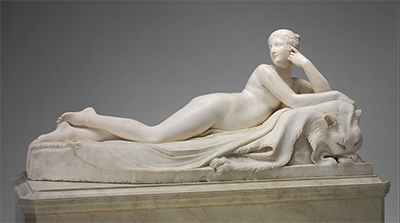Naiad depicts a nude nymph reclining and is typical of much of Antonio Canova's work, who was famed for his female nudes. Naiad was sculpted in carrara marble and was commissioned by the Fourth Earl of Darnley, John Bligh.
It is thought to have been completed towards the end of Canova's career, sometime between 1819-1824. Born in 1757, Canova learnt sculpting from his grandfather, a stonemason, who gained custody of the young Canova when his mother remarried in 1762. Italian Antonio Canova often drew inspiration from Greek mythology, with his Naiad typifying the beautiful naked nymphs that appear throughout the Grecian myths. Other notable works include his sculptures of Theseus and the Minotaur, as well as another famous characters from mythology, including the ill-fated Icarus along with Cupid and Psyche, amongst many others.
By the time he came to carve Naiad, Canova was one of the most celebrated sculptors in Europe and his work was in high demand. He worked for several European patrons, including Napoleon Bonaparte, before returning to his native Italy where he saw out the rest of his career. Naiad encompasses Canova's influences from artists such as Michelangelo, whom he studied extensively, as well as inspiration from the romanticism and melodrama of the Baroque and Rococo styles. His contemporaries marvelled that his works were current and not in fact artefacts from the Greek period, so exacting were his skills as a sculptor. Naiad evokes all the languorous sensuality of a nymph, with her curved body draped over the plinth as she turns her attention away to the unseen object of her affection.
The Naiads of Greek mythology were almost like fairies, falling somewhere between man and beast, so it is perhaps no surprise that beneath the folds of fabric the Naiad reclines on, an animal head can be faintly seen with two paws tucked just underneath. The cloth or fabric itself has a fluid quality, which is again rather appropriate as nymphs were synonymous with water and can often be seen in art as depicted holding or pouring water. The life-sized sculpture is evocative, arresting and undeniably erotic. Naiad is part of the permanent collection at the National Gallery of Art, Washington D.C.




